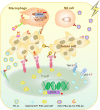Exosomes reveal the dual nature of radiotherapy in tumor immunology
- PMID: 35218675
- PMCID: PMC8990792
- DOI: 10.1111/cas.15314
Exosomes reveal the dual nature of radiotherapy in tumor immunology
Abstract
Radioresistance is the potential cause of cancer metastasis and recurrence. Radiation-induced changes in exosomes can partially explain the undesirable prognosis of radiotherapy (RT). Exosomes, newly discovered ways of cell communication, carry the characteristics of their origin, resulting in their diversity. Various exosomes in the tumor microenvironment exert different function in immune response. In this review, the dual effect of RT on the immune system was described, and the effect of radiotherapy on tumors via exosomes was explored. The molecules in exosomes after RT were described to play immunosuppressive and immunocompetent roles: immune-related receptors and cell signaling molecules involved in both adaptive and innate immune system were present. CD69, TIGIT, TIM-3, LAG-3 and the tumor necrosis factor (TNF) family that signal to T cells were shown to be regulated by exosomes after irradiation. The change in innate immunity-derived like receptors, Leukocyte Immunoglobin-Like Receptors (LILR) was described, as well as B7-H3, V-domain containing Ig suppressor of T cell activation (VISTA), and CD155 on tumor cells. These changed molecules inhibit and activate the immune system through different mechanisms. By analyzing the relationship between exosome-derived molecules and immunity, this review shows that radiotherapy can induce immunosuppression and immune clearance through exosomes, thereby treating tumors and improving patient prognosis.
Keywords: cancer; exosome; immunomodulation; radiotherapy.
© 2022 The Authors. Cancer Science published by John Wiley & Sons Australia, Ltd on behalf of Japanese Cancer Association.
Conflict of interest statement
The authors have no conflicts of interest.
Figures



Similar articles
-
Landscape of tumor and immune system cells-derived exosomes in lung cancer: mediators of antitumor immunity regulation.Front Immunol. 2023 Oct 17;14:1279495. doi: 10.3389/fimmu.2023.1279495. eCollection 2023. Front Immunol. 2023. PMID: 37915578 Free PMC article. Review.
-
Critical immunosuppressive effect of MDSC‑derived exosomes in the tumor microenvironment.Oncol Rep. 2021 Mar;45(3):1171-1181. doi: 10.3892/or.2021.7936. Epub 2021 Jan 14. Oncol Rep. 2021. PMID: 33469683 Free PMC article.
-
A Clinician's Guide to Cancer-Derived Exosomes: Immune Interactions and Therapeutic Implications.Front Immunol. 2020 Jul 22;11:1612. doi: 10.3389/fimmu.2020.01612. eCollection 2020. Front Immunol. 2020. PMID: 32793238 Free PMC article. Review.
-
Engineered exosome-like nanovesicles suppress tumor growth by reprogramming tumor microenvironment and promoting tumor ferroptosis.Acta Biomater. 2021 Nov;135:567-581. doi: 10.1016/j.actbio.2021.09.003. Epub 2021 Sep 8. Acta Biomater. 2021. PMID: 34506976
-
Role of exosomes in the immune microenvironment of ovarian cancer.Oncol Lett. 2021 May;21(5):377. doi: 10.3892/ol.2021.12638. Epub 2021 Mar 15. Oncol Lett. 2021. PMID: 33777201 Free PMC article. Review.
Cited by
-
Exosomes: A potential tool for immunotherapy of ovarian cancer.Front Immunol. 2023 Jan 18;13:1089410. doi: 10.3389/fimmu.2022.1089410. eCollection 2022. Front Immunol. 2023. PMID: 36741380 Free PMC article. Review.
-
Mechanism of exosomes in the tumor microenvironment in the abscopal effect (Review).Int J Oncol. 2023 Jan;62(1):2. doi: 10.3892/ijo.2022.5450. Epub 2022 Nov 11. Int J Oncol. 2023. PMID: 36367187 Free PMC article.
-
Exosome as a crucial communicator between tumor microenvironment and gastric cancer (Review).Int J Oncol. 2024 Mar;64(3):28. doi: 10.3892/ijo.2024.5616. Epub 2024 Jan 19. Int J Oncol. 2024. PMID: 38240092 Free PMC article. Review.
-
Combined Radiotherapy and Hyperthermia: A Systematic Review of Immunological Synergies for Amplifying Radiation-Induced Abscopal Effects.Cancers (Basel). 2024 Oct 30;16(21):3656. doi: 10.3390/cancers16213656. Cancers (Basel). 2024. PMID: 39518094 Free PMC article. Review.
-
Mesenchymal stem cells derived exosomes: a new era in cardiac regeneration.Stem Cell Res Ther. 2025 Jan 23;16(1):16. doi: 10.1186/s13287-024-04123-2. Stem Cell Res Ther. 2025. PMID: 39849585 Free PMC article. Review.
References
-
- Pegtel DM, Gould SJ. Exosomes. Annu Rev Biochem. 2019;88:487‐514. - PubMed
-
- Meldolesi J. Exosomes and ectosomes in intercellular communication. Curr Biol. 2018;28(8):R435‐R444. - PubMed
-
- Thery C, Zitvogel L, Amigorena S. Exosomes: composition, biogenesis and function. Nat Rev Immunol. 2002;2(8):569‐579. - PubMed
-
- Duijvesz D, Luider T, Bangma CH, Jenster G. Exosomes as biomarker treasure chests for prostate cancer. Eur Urol. 2011;59(5):823‐831. - PubMed
Publication types
MeSH terms
Grants and funding
LinkOut - more resources
Full Text Sources
Medical
Research Materials

